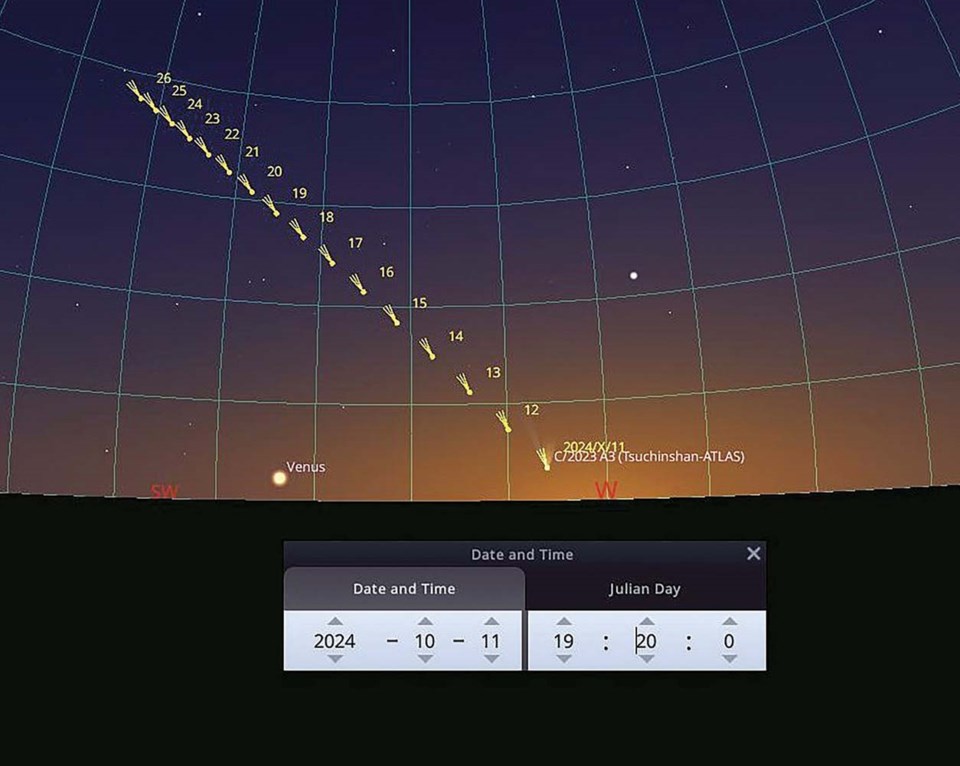The good news for October is that the moon is occulting a bunch of solar system objects as well as another star and close passes to others. It passes in front of the sun Oct. 2 – an annular eclipse, Antares Oct. 7, Saturn Oct. 14 and Neptune Oct. 15. The bad news is that from Sechelt we won’t be able to see any of them. We will, however, see the largest full moon of the year in the early morning of Oct. 17. The moon’s closest approach to Earth this year – 357,174 km – occurs at 6 p.m. on Oct. 16, with the full moon about 11 hours later. We can expect larger than normal tide ranges around that time.
We can also expect to see a new comet, C/2023 A3 Tsuchinshan-ATLAS, the name of which I will not even attempt to pronounce. It was discovered in early 2023 and appears to be inbound from the Oort Cloud, a region of icy remnants far past the range of the planets and left over from the formation of the solar system. At these distances, objects are just barely within the gravitational influence of our star. The comet will reach perihelion on Sept. 27, at about .39 AU (AU is the mean distance from Earth to the sun) so it will be about as far from the sun as Mercury. This close approach to the sun should drive off significant amounts of gas and dust and it is possible it could yield a bright naked-eye comet. I’ve read some speculation that it could be visible in daylight like Hale-Bopp in 1997 and McNaught in 2007 but comets are famously unpredictable, just like cats. Since the comet appears to be coming in from so far out, it seems likely that it has not been exposed to solar heat in a very long time, perhaps never. If so, there should be lots of surface ice and potential volatiles to vaporize and provide a good show.
Comet 2023 A3 has approached from south of the planetary plane and will cross through and head back out north of that plane so we’ll have a good view of it leaving. It should be visible in the west after sunset by about Oct. 10, makes its closest approach to Earth on Oct. 12 and will move up and left each day as it speeds away from the sun. Venus will be about 5 degrees above the horizon in the southwest. The comet should be visible about twice the width of your fist to the right and will climb to about 30 degrees above the horizon and directly above Venus by the end of the month. The attached Stellarium screenshot show the expected location of the comet for most of October. The Astronomy Picture Of the Day website, APOD, has a beautiful picture of the comet plus a couple of distant galaxies; check the Archive tab for Sept. 23 and enjoy! That website is: apod.nasa.gov/apod/astropix.html.
The Orionid meteor shower peaks on Oct. 21 but good viewing is spread over several days. The parent body for these meteors is good old Comet Halley and these meteors are notably fast –– they enter our atmosphere doing over 60 km per second. They also tend to leave trails, which can persist for several seconds. The best viewing will normally be after midnight when the radiant point, just above and left of Betelgeuse, the bright star at the top left of Orion, is above the eastern horizon. As with any meteor shower, the best viewing comes from looking straight up with the widest clear field of view you can find.
Keep checking the site spaceweather.com for a daily update on the T Corona Borealis nova expected in the next few months. That site is also an excellent source for info on solar flares, coronal mass ejections and the likelihood of aurorae we might see.
The next SCAC monthly meeting will be at the Sechelt Library, Oct. 4. The club AGM will be at 7 p.m. and the public meeting should start by 7:30 p.m. with a lecture by Bryan Elliott from the Vancouver center of the RASC. He will be presenting on the dark skies of Pitcairn Island. Check the club website at: sunshinecoastastronomy.wordpress.com.



